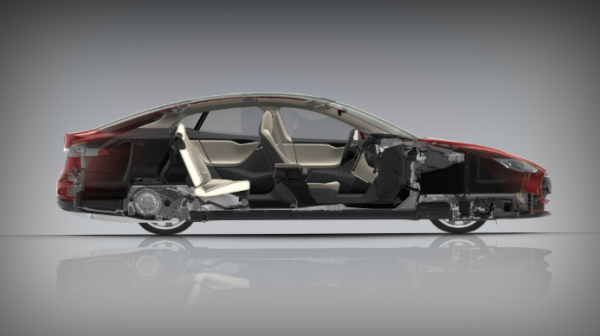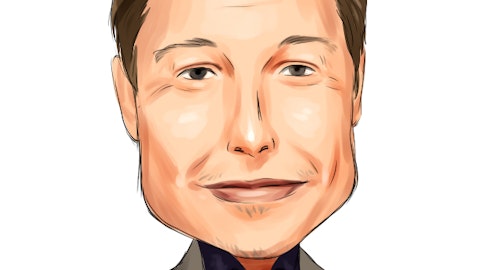Tesla Motors Inc (NASDAQ:TSLA) announced late on Tuesday that it had created what it called a “revolutionary automotive financing product”, in conjunction with U.S. Bancorp (NYSE:USB) and Wells Fargo & Co (NYSE:WFC).

It’s not a lease program – more on that below – but it’s meant to be similar to a lease, and a way to make the company’s electric Model S sedan accessible to more buyers. Tesla Motors Inc (NASDAQ:TSLA) wasted no time updating its website to tout a “true cost of ownership” of “$500 a month”, a claim that CEO Elon Musk reiterated to Bloomberg.
That’s an impressively low-sounding payment on a luxury sedan that starts at $62,400 (after a $7,500 federal tax credit) and can be optioned up to over $100,000.
But it turns out that the $500-a-month claim comes with an awfully big asterisk, and some observers are already saying that Tesla Motors Inc (NASDAQ:TSLA)’s numbers don’t add up.
Some dubious “savings” to get to that $500
The financing product is essentially a 66-month loan with a 2.95% interest rate, with a few interesting twists. The banks will provide qualified customers with 10% of the purchase price, an amount that will be largely reimbursed by that federal tax credit and various state green-car incentives.
And after three years, the buyer has the option of selling the car back to Tesla at a value pegged to the depreciation rate of the Mercedes-Benz S Class, one of the world’s best regarded luxury sedans.
It’s an interesting program that tries to simulate the experience of a lease by doing away with down payments and offering a chance to “turn the car in” at what is likely to be a good price after three years. It’s obviously meant to compete with the popular leasing programs offered by luxury-car makers like Mercedes and BMW. And as I said above, Tesla Motors Inc (NASDAQ:TSLA) is already advertising it that way, touting a $500 monthly cost of ownership.
But that cost of ownership calculation comes with an awfully big asterisk, or really several asterisks: To get to that number, Tesla Motors Inc (NASDAQ:TSLA) is factoring in owners’ savings on gasoline – as well as a bunch of more iffy benefits, like the tax savings that could come from claiming the car as a business expense, and a placing a monetary value on the time you save by not driving to the gas station.
Your real monthly payment, before all those “savings”? No less than $1,097. That’s the payment on the cheapest Model S available, according to Tesla.
The savings on gas are real, the others less so for most, but none will reduce the size of the check you’ll have to write to the bank every month. If you were hoping for a cheap way to buy a Model S, I think you’ll have to keep hoping.
But why can’t Tesla just offer regular leases?
Because nobody (yet) knows what a Model S is going to be worth in three years.
The banks and financing companies that offer new-car leasing programs have a pretty good idea of what the car you’re leasing is going to be worth when the lease is up. That value, called the car’s residual value, is the starting point for calculating the monthly payment that will be required under the terms of the lease.
Those finance companies have access to data on millions of used-car sales, which gets crunched a lot of different ways. With most cars, even brand-new models from established automakers like Ford Motor Company (NYSE:F) or Toyota Motor Corporation (NYSE:TM), using all of that data to calculate the likely average value of a used example is a straightforward exercise.
But with Tesla Motors Inc (NASDAQ:TSLA), all that data is pretty much worthless, for a bunch of reasons. First and foremost, few if any Model S’s have been sold on the used-car market, so there aren’t many Tesla-specific transactions to look at. And it’s hard to predict how the Model S will be valued by the market in time, because it’s unclear how the car will age.
What’s more, the car isn’t just a new design, it’s from a new automaker. And it’s powered by a technology that isn’t exactly unheard-of, but hasn’t been implemented this way before on any kind of mass-market scale. How reliable will the Model S be in the long term, and how will that reliability affect demand for used Teslas? We don’t know yet.
What’s more, Tesla the company hasn’t (yet) reported a profit. Will the company even be around in three years? (To be clear, I think it will be, but can you see where a bank might not be willing to bet its own money on that?) If Tesla isn’t around to provide parts and service and upgrades and an ongoing market, its cars might not be worth much except as collectors’ curiosities.
It’s not a bad program, but “$500 a month” is a stretch
Those are probably some of the considerations that drove Musk to create this alternative financing program with U.S. Bancorp (NYSE:USB) and Wells Fargo & Co (NYSE:WFC). By pegging the residual value of a used Model S to that of the top of the line Mercedes, Tesla is essentially establishing a floor for the future market – and putting their own cash behind the idea that a Model S will hold its value for a while.
That’s a savvy move that will help the company establish a real leasing program in the not too distant future. And that will be a very good thing for Tesla’s sales when it happens.
But meanwhile, the idea that you can drive a Model S for $500 a month is still just a nice idea for most folks, no matter what Musk says.
The article Tesla’s Numbers Don’t Add Up originally appeared on Fool.com.
Fool contributor John Rosevear owns shares of Ford. Follow him on Twitter at @jrosevear. The Motley Fool recommends BMW, Ford, Tesla Motors, and Wells Fargo. The Motley Fool owns shares of Ford, Tesla Motors, and Wells Fargo.
Copyright © 1995 – 2013 The Motley Fool, LLC. All rights reserved. The Motley Fool has a disclosure policy.
